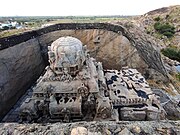Vettuvan Koil
| Vettuvan Koil | |
|---|---|
 | |
| Religion | |
| Affiliation | Hinduism |
| District | Thoothukudi |
| Deity | Vettuvan Koil(Shiva) |
| Location | |
| Location | Kalugumalai |
| State | Tamil Nadu |
| Country | India |
Location in Tamil Nadu | |
| Geographic coordinates | 9°09′11″N 77°42′16″E / 9.1529512°N 77.7043968°E |
| Architecture | |
| Type | Dravidian architecture, Rock cut |
| Creator | Early Pandya dynasty |
| Completed | 8th century CE |
| Website | |
| kalugumalaitemple | |
Vettuvan Koil in Kalugumalai, a panchayat town in Thoothukudi district in the South Indian state of Tamil Nadu, is a temple dedicated to the Hindu god Shiva. Constructed in the Pandyan Architecture and rock cut architecture, the unfinished temple was built during the 8th century CE by the early Pandyas. The other portions of Kalugumalai hillock houses the 8th century Kalugumalai Jain Beds and Kalugasalamoorthy Temple, a Murugan temple.[1]
This rock-cut temple is notable for its architecture and construction method. While the early Pandya rulers helped build numerous cave and stone temples, it is the only known example of a Pandya era monolithic temple that was carved out in three dimensions, in-situ from the top of the hillock.[2]
The temple is maintained and administered by Department of Archaeology of the Government of Tamil Nadu as a protected monument.
Location and date[edit]

The Vettuvan Koil is in Kalugumalai, about 60 kilometers north of Tirunelveli and 20 kilometers west of Kovilpatti. It is located in Thoothukudi district in southern Tamil Nadu. The temple sits on the top of a stone hillock on the eastern side. It opens and overlooks to the east, but shares the entrance and a walk path from the west side of the hillock with the Kalugumalai Jain Beds (Highway 187). The temple was built in the 8th century along with the Kalugumalai Jain Beds under the patronage of Parandhagan Netunjadaiyan of the early Pandyan era.[2][3]
Architecture[edit]

The temple is carved out from a single rock in a rectangular portion measuring 7.5 m (25 ft) in depth. The carvings in the temple show the top portion of the temple, with an unfinished bottom. The sculptures and the carvings are indicative of Pandyan art during the period.[3] The granite rock looks like a blooming lotus, with hills surrounding it on three sides. The vimana (ceiling over the sanctum) has niches of Parsavadevatas, the attendant deities of Shiva, like ganas, Dakshinamurthy depicted playing a mridanga, Siva with his consort Uma, dancers, various niches of Nandi (the sacred bull of Shiva) and animals like monkeys and lions. Historian Sivaramamurti states that this is the only site where Dakshinamurthy is depicted playing the Mridanga (a percussion instrument), while in all other places, he is depicted playing Veena. According to epigrapher V. Vedachalam, there is a spontaneity in the sculptures indicating of natural human movements like in the Shiva and Uma sculpture where they seem to be talking like common folks.[4] The Vettuvan Koil is an unfinished Shiva temple.
The other portions of Kalugumalai hillock houses the 8th-century-CE Jaina Abode (southwest of Vettuvan Koil) and Kalugasalamoorthy Temple to the south end of the hillock.[5][6]
Historians have equated the temple with similar temples across India based on the monolithic classification and being carved in-situ out of a pre-existing rock. Historian K. V. Soundara Rajan believes that the temple is similar in architecture to that of Virupaksha Temple at Karnataka by Vikramaditya II during 734–44 CE, Kanchi Kailasanathar Temple built by Narasimhavarman II during 685–705 CE and Kailasa temple, Ellora by Krishna I during 756–77 CE.[7] Some historians suggest that the similarities in the architecture are indicative of the political relations between the Pallavas, Rashtrakutas and Chalukyas. This view has been disputed by other historians.[8]
Preservation[edit]
Vettuvan Koil is maintained and administered by Department of Archaeology of the Government of Tamil Nadu as a protected monument.[9] Kalugumalai was chosen in the plan to be included as a rural tourism site in Incredible India campaign by the Tourism Ministry of the Government of India.[10] As a part of the campaign the ministry allocated ₹10 million to develop the infrastructure around the region in 2008. The tourist inflow to the town increased to 3,000 persons per month during 2009 from 400 per month during the previous years.[11]
Gallery[edit]
References[edit]
- ^ "Kazhugumalai –Jain Temple". Archived from the original on 4 March 2016. Retrieved 25 December 2015.
- ^ a b G. Ezhil Adirai (2016), TECHNOLOGICAL METHODS IN MAKING SCULPTURES, Proceedings of the Indian History Congress, Vol. 77, pp. 84-85, JSTOR 26552626
- ^ a b "Sthala Varalaru". Hindu Religious and Endowment Board, Government of Tamil Nadu. 2015. Retrieved 4 November 2015.
- ^ "Opulent sculptures". 22 (25). Tuticorin: Frontline. 24 August 2008. Retrieved 4 November 2015.
{{cite journal}}: Cite journal requires|journal=(help) - ^ "Kazhugumalai deserves universal recognition". The Hindu. Tuticorin. 8 August 2012. Retrieved 4 November 2015.
- ^ Virupa, Kumaresan, ed. (2014). பல்நோக்குப் பார்வையில் முருகத் தத்துவம் II: Proceedings of the International Conference on Murugabhakthi 2014. Thirumurugan Thiruvakku Thirupeedam. p. 1047.
- ^ "Southern connection". Frontline. 25 July 2014. Retrieved 4 November 2015.
- ^ Cammiade, L.A. (October 1930). "Observations Upon Ancient Sites in the Neighbourhood of Kalugumalai, Madras Presidency". Man. 30. Royal Anthropological Institute of Great Britain and Ireland: 187–89. doi:10.2307/2790466. JSTOR 2790466.
- ^ "Protected Monuments under the control of the Department". Department of Archaeology, Government of Tamil Nadu. 2011. Retrieved 4 November 2015.
- ^ "14 more rural tourism sites to be ready". Hindustan Times. New Delhi, India. 29 May 2008. Archived from the original on 9 April 2016. Retrieved 4 November 2015.
- ^ "Tourism shoots up in picturesque Tamil temple town". Hindustan Times. New Delhi, India. 1 January 2009. Archived from the original on 18 October 2016. Retrieved 4 November 2015.



